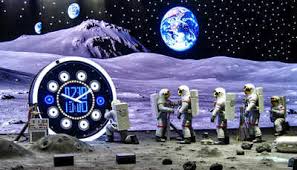WASHINGTON (AFP): The White House announced Tuesday it is directing NASA to create a unified time standard for the Moon and other celestial bodies, as governments and private companies increasingly compete in space.
With the United States keen to set international norms beyond Earth’s orbit, the White House Office of Science and Technology Policy (OSTP) instructed the US space agency to formulate a plan by the end of 2026 for a standard it is calling Coordinated Lunar Time.
“As NASA, private companies, and space agencies around the world launch missions to the Moon, Mars, and beyond, it’s important that we establish celestial time standards for safety and accuracy,” OSTP Deputy Director for National Security Steve Welby said in a statement.
He noted how “time passes differently” depending on positions in space, offering the example of how time appears to pass more slowly where gravity is stronger, such as near celestial bodies.
“A consistent definition of time among operators in space is critical to successful space situational awareness capabilities, navigation, and communications,” Welby said.
The aim, the White House says, is for Coordinate Lunar Time, or LTC, to be tied to Coordinated Universal Time (UTC), currently the primary time standard used throughout the world to regulate time on Earth.
The White House directed NASA to work with the Departments of Commerce, Defense, State and Transportation to deliver a time standard strategy that will improve navigation and other operations for missions in particular in cislunar space, the region between Earth and the Moon.
The new standard will focus on four features: traceability to UTC, accuracy sufficient to support precision navigation and science, resilience to loss of contact with Earth, and scalability to environments beyond cislunar space.
There were few technical specifics for establishing a lunar time standard laid out in the memorandum, but OSTP suggested it could adopt elements of the existing standard on Earth.
“Just as Terrestrial Time is set through an ensemble of atomic clocks on Earth, an ensemble of clocks on the Moon might set Lunar Time,” it said.
The United States is planning a return to the Moon in 2026, humanity’s first lunar landing since the Apollo 17 mission in 1972.
Space debris
NASA said Tuesday it was analyzing an object that crashed from the sky into a Florida man’s home — which could well be a piece of debris jettisoned from the International Space Station.
Alejandro Otero of Naples, Florida, posted on X that the item “tore through the roof and went (through) 2 floors” of his house, almost striking his son, on the afternoon of March 8.
He believes it was a piece of a cargo pallet containing old batteries that NASA ground control teams released from the orbital outpost in 2021.
It was supposed to burn up harmlessly over the Earth’s atmosphere on March 8, according to official projections. Otero also posted a clip from his home Nest video camera where he said the sound of it crashing through his roof could be heard at 2:34 pm.
“So that’s 1934 UTC, which is very consistent with the Space Force estimate of reentry over the Gulf at 1929 UTC,” wrote noted astrophysicist Jonathan McDowell, in response. “I think you may be right and it’s a bit from the reentry of the EP-9 battery pallet.”
The news was first reported by local news outlet winknews.com on March 15.
“NASA collected an item in cooperation with the homeowner, and will analyze the object at NASA’s Kennedy Space Center in Florida as soon as possible to determine its origin,” the space agency said in a statement to AFP on Tuesday. “More information will be available once the analysis is complete.”
A report by specialist news outlet Ars Technica said while the batteries were owned by NASA, they were attached to a pallet structure launched by Japan’s space agency — potentially complicating liability claims.
Past examples of manmade human space debris hitting Earth include part of a SpaceX Dragon capsule landing on an Australian sheep farm in 2022. Skylab, the United States’ first space station, fell on Western Australia.
More recently, China has been criticized by NASA for allowing its giant Long March rockets to fall back to Earth after orbit.







